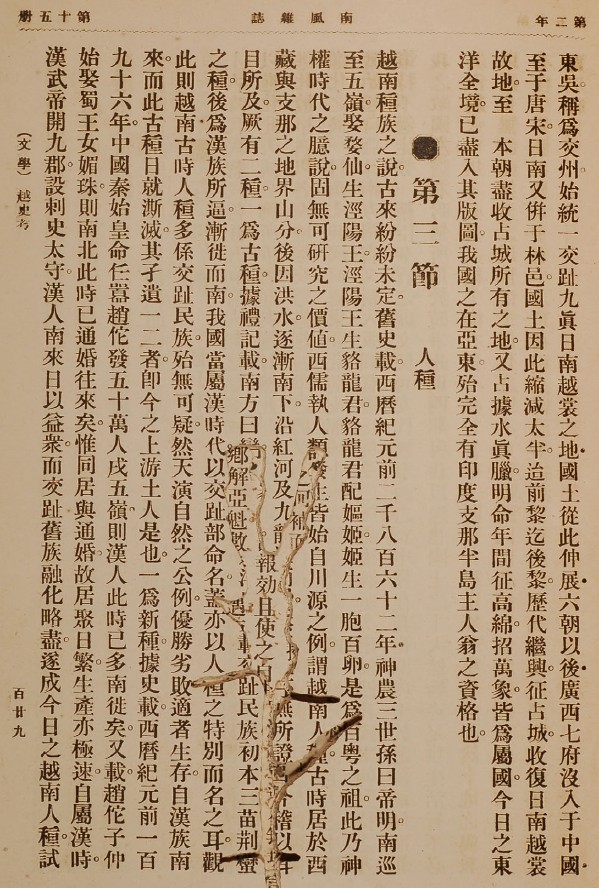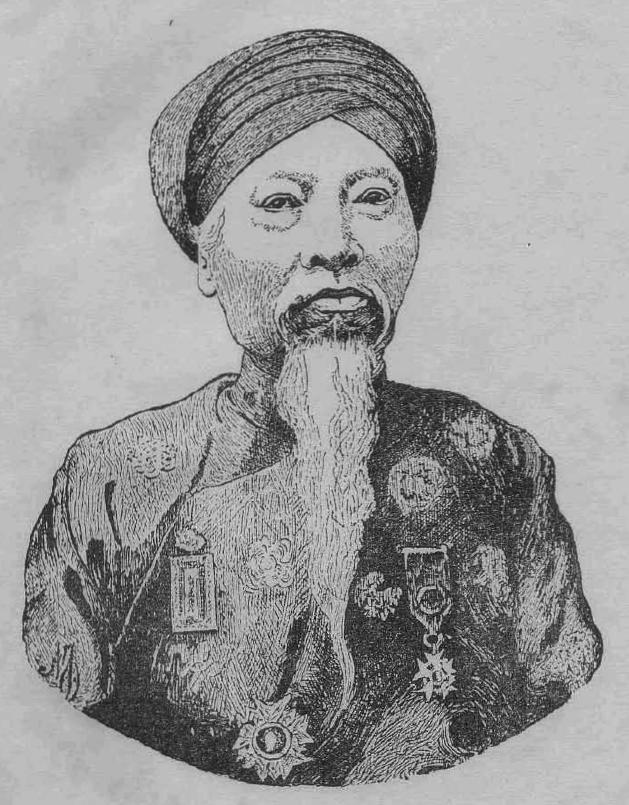Following the ideas of the previous two blog entries below, one of the main elements of the dominant paradigm of Vietnamese history is that Vietnamese have always felt patriotic towards their nation.
Contrary to this assertion, we can clearly document the emergence of the concept of patriotism (ái quốc in Hán, but commonly expressed now as lòng yêu nước in tiếng Việt) in Vietnam to the early twentieth century. We can see its emergence at that time in, among other places, a new style of textbook that was published which clearly promoted this concept, and which clearly indicated that it was new.
One example of such works is the Cải lương mông học quốc sử giáo khoa thư (改良蒙學國史教科書). I’m not sure about the exact publication date for this work, but it should be around 1912 or so. Its argument about the need for a new mindset is similar to what can be found in works like the Việt sử yếu (越史要) from 1914.
What is the new mentality that these works encouraged? They argued that “Vietnamese” (Note that in the passage below the Cải lương mông học quốc sử giáo khoa thư does not use this term. I’m just using it here for the sake of simplicity.) did not have a sense of patriotism because they had never really thought about their own land. Instead, they had just focused on learning about that big place to the north.
This was one of the most important intellectual changes that took place at that time. After centuries of living in a world in which educated Vietnamese valued certain knowledge as universal (what we would today call “Chinese” knowledge), in the early twentieth century educated Vietnamese moved away from that way of viewing the world and started to emphasize the need to know about their own land.
Why did this happen? It is because Vietnamese intellectuals at that time came to learn of the concept of the nation, and that in the West people did not emphasize some universal form of knowledge as they did, but valued instead information about their own individual countries.
This was a new concept, as were many terms associated with it such as:
“nation” – It is often difficult to detect when this concept is being used in this transition period, because the term for “kingdom” (quốc 國) was used to indicate this new concept as well. So when intellectuals in the early twentieth century talked about “quốc sử” (國史), it is difficult to know if they meant “national history” or “the history of the kingdom.”
“nationality” (dân tộc 民族) – This was a new concept. It was created by Japanese reformers in the second half of the nineteenth century, and then entered the Chinese language.
“fatherland” (tổ quốc 祖國) – Another new concept at the time which was probably created in Japan as well.
“citizen” (quốc dân 國民) – Also created in Japan to translate a concept that did not exist in languages like Japanese and Chinese.
With all of this in mind, let’s look at the opening part of the preface to the Cải lương mông học quốc sử giáo khoa thư:
“In a realm there are three things of importance. The first is history. A nation’s/kingdom’s history records the [times of] strength and weakness of a nation’s/kingdom’s nationality [dân tộc], and the speed of their evolution. Studies in the Occident [old word for the West – 泰西] place first importance on national history. All of the male and female students in each school are first taught their own nation’s history, and then the histories of foreign countries. Children practice it, and when they get bigger they become adept at it.
Trong cõi có ba điều quan trọng, một trong số đó là sử. Quốc sử là cái dùng để ghi lại sự mạnh yếu của dân tộc và sự nhanh chậm trong tiến hóa của nó. Sự học của Thái Tây trọng hơn hết là quốc sử. Hễ trong trường học, học sinh nữ hay nam đều trước hết dạy cho lịch sử bản quốc, sau đó [học] đến lịch sử nước ngoài. Lúc đồng ấu học tập thứ ấy, lớn lên sẽ tinh thông thứ ấy.
“Reading the history of the [times of] strength and prosperity of one’s fatherland, one becomes happy. Reading the history of the [times of] decline and weakness of one’s fatherland, one becomes sad. These citizens will then gain a strong sense of patriotism. Everyone will exert their utmost to move the fatherland toward strength and prosperity, and to raise their fatherland’s reputation. The history of a nation truly has the most intimate of relations with its citizens.
Đọc lịch sử [khi] tổ quốc cường thịnh thì vui sướng mà kính nể. Đọc lịch sử [khi] tổ quốc suy vi thì xót xa mà buồn thương. [Như thế] nên những quốc dân [đọc sử ấy] được làm giàu có [thêm] lòng yêu nước; [mà] người người sẽ hết sức gắng gỏi để thúc đẩy tổ quốc đến cường thịnh và làm danh dự tổ quốc được vẻ vang. Quốc sử đối với quốc dân thực có quan hệ mật thiết nhất.
“Studies in our kingdom/nation just stick to using rotten Chinese [It’s very interesting that the author uses 支那 Chi Na. This was a derogatory term used by the Japanese at the time (Shina in Japanese).] writings. As for this nation’s [writings], they know nothing, as if they were in a fog. Even if you ask high-class students which nation/kingdom they live in, they cannot answer. Oh! The people of this nation/kingdom are not clear about the matters of this nation/kingdom, [like] Ji Tan forgetting his ancestors [A reference to a person in the Zuozhuan], and almost don’t even know the origin of their own bloodline [This is another new concept.]. Therefore the spirit of patriotism is shallow and weak, causing the fatherland’s future to daily descend into the realm of decline and oblivion.”
Sở học của nước ta rặt chỉ theo nước China mà mô phỏng lối văn hủ lậu, thứ đó (=lối văn hủ lậu) đối với bản quốc vì thế thực là mông lung, [người học học nó thì] như sa vào chốn sương mù. [Điều đó khiến cho] đến mức học sinh cao đẳng trong xã hội lớp trên mà [khi] hỏi rằng thân này ở nước nào cũng không thể đối đáp được. Ôi! Với việc quốc nhân mình không biết rõ quốc sự mình, [khác gì] [chuyện] “Tịch Đàm vong tổ” (Tịch Đàm quên tổ tiên của mình)? Cơ hồ không biết huyết thống thân ta từ đâu mà ra, cho nên lòng yêu nước đã nông cạn lại mỏng bạc, mà khiến cho tiền đồ tổ quốc ngày càng hãm vào vực suy nhược chìm vong.
*****
What I have translated as “patriotism” here is “ái quốc tâm” (愛國心) or “ái quốc chi tâm” (愛國之心). While you can find the term “ái quốc” used prior to this point, it did not carry the same sense as the term “patriotism.” What was valued prior to the twentieth century was loyalty (trung 忠) to a monarch. “Ái quốc” thus indicated more of a connection to the monarch, the royal enterprise, and the monarch’s kingdom than a connection with “the citizens” and the land, which patriotism emphasizes.
For people to have a sense of “patriotism,” they had to think of their land as a “nation” with “citizens” and a “national history” about this “fatherland” that the “nationality” needed to know so that they could feel a sense of “patriotism.”
The curriculum that scholars studied before the twentieth century emphasized very different points. People needed to learn the classics in order to develop the morality that they would need to govern well and to maintain their loyalty to the monarch.
Further, those classics were universal. It was thus impossible to have a modern/Western sense of patriotism when one’s education focused on material that came from someplace else.
The Cải lương mông học quốc sử giáo khoa thư demonstrates that intellectuals in the early twentieth century were coming to this realization, and were attempting to dramatically change the way that people in their land viewed the world they lived in.
A century later we can see that they definitely succeeded. Today many people are unaware that this transition ever took place. As a result, the dominant paradigm that declares that the Vietnamese have always had a sense of patriotism toward their nation gets repeated over and over.








